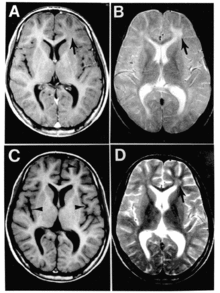User:Mr. Ibrahem/Subacute sclerosing panencephalitis
| Subacute sclerosing panencephalitis | |
|---|---|
| Other names | Dawson disease |
 | |
| Subacute sclerosing panencephalitis. | |
| Symptoms | Initial memory loss and irritability; followed by involuntary jerking movements[1] |
| Complications | Seizures, blindness[1] |
| Usual onset | 7-10 yrs after infection with measles[2] |
| Causes | Measles virus[3] |
| Diagnostic method | Based on symptoms, CSF analysis, EEG, medical imaging, brain biopsy[3] |
| Differential diagnosis | Viral encephalitis, autoimmune encephalitis, multiple sclerosis, Creutzfeldt-Jakob disease[3] |
| Prevention | Measles vaccine[1] |
| Treatment | Supportive care[3] |
| Medication | Antivirals, antiseizure medication, antispasmodics[1] |
| Prognosis | Usually fatal within 3 yrs[1] |
| Frequency | About 1 in 10,000 people infected by measles[2] |
Subacute sclerosing panencephalitis (SSPE) is progressive brain inflammation due to persistent measles infection.[3] Onset is generally 7 to 10 years after the initial infection.[2] Initial symptoms include memory loss and irritability which is followed by involuntary jerking movements.[1] Complications may include seizures and blindness.[1]
It is caused by wild-type measles virus, not by vaccine strains.[3] Diagnosis may be based on a combination of symptoms, CSF analysis, EEG findings, medical imaging, and brain biopsy.[3] It differs from the other forms of encephalitis due to measles: primary measles encephalitis, acute post-measles encephalitis, and measles inclusion body encephalitis.[4]
Prevention is by measles vaccination.[1] There is no cure.[1] Treatment may involve the use of antiviral medication such as ribavirin, antiseizure medication, and antispasmodics.[1] Most individuals die within 3 years of the diagnosis.[1]
SSPE affects about 1 in 10,000 people who get measles; though it is more common in those who had measles before the age of 5.[2][5] Rates decreased more than 90% with widespread vaccination against measles.[1] The condition primarily affects children and young adults.[1] Males are more commonly affected than females.[1] The condition was first described in 1933 by Dawson.[6]
References[edit]
- ^ a b c d e f g h i j k l m n "Subacute Sclerosing Panencephalitis Information Page | National Institute of Neurological Disorders and Stroke". www.ninds.nih.gov. Retrieved 16 May 2021.
- ^ a b c d "Measles - Vaccine Preventable Diseases Surveillance Manual | CDC". www.cdc.gov. 13 May 2019. Retrieved 16 May 2021.
- ^ a b c d e f g Rocke, Z; Belyayeva, M (January 2021). "Subacute Sclerosing Panencephalitis". PMID 32809508.
{{cite journal}}: Cite journal requires|journal=(help) - ^ "Measles-induced encephalitis". QJM. 108 (3): 177–182. 2015. doi:10.1093/qjmed/hcu113. PMID 24865261.
{{cite journal}}: Cite uses deprecated parameter|authors=(help) - ^ Mekki, M; Eley, B; Hardie, D; Wilmshurst, JM (October 2019). "Subacute sclerosing panencephalitis: clinical phenotype, epidemiology, and preventive interventions". Developmental medicine and child neurology. 61 (10): 1139–1144. doi:10.1111/dmcn.14166. PMID 30680706.
- ^ Morris, Huw (2005). Neurology Update: Reviews for Continuing Professional Development. Radcliffe Publishing. p. 77. ISBN 978-1-85775-722-4.
